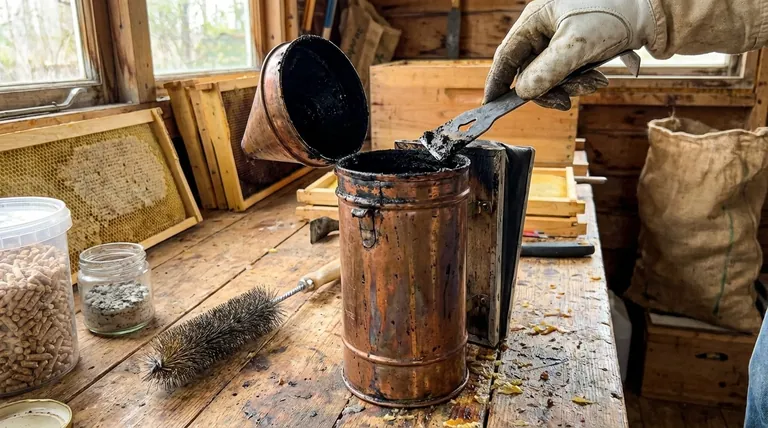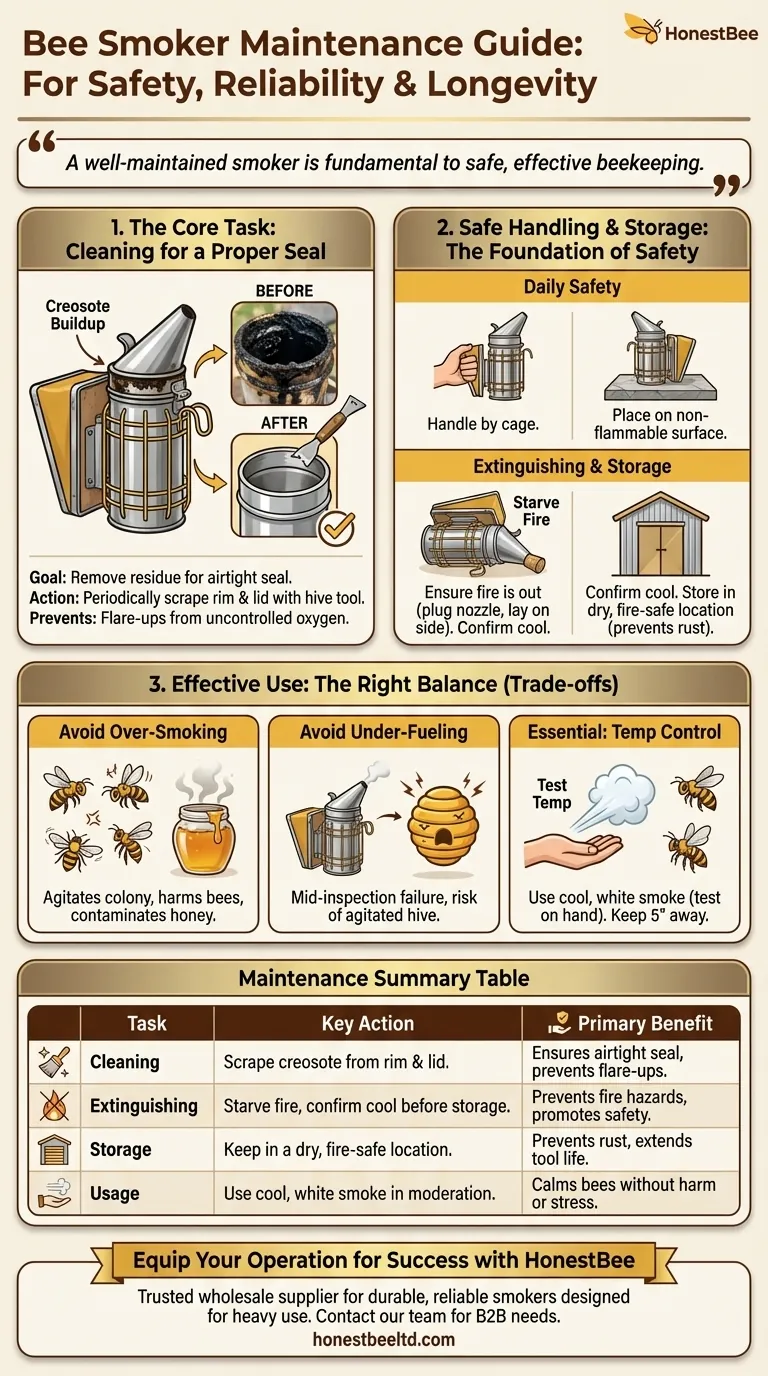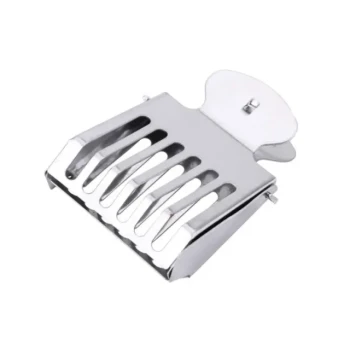Proper bee smoker maintenance is straightforward and centers on two key practices. You must periodically clean the built-up creosote and soot from the smoker's canister, particularly around the rim and lid, to ensure a proper seal. Additionally, always make sure the smoker is completely extinguished and cool before storing it in a dry, safe place to prevent fire hazards and prolong its life.
A well-maintained smoker is not just about tool longevity; it is a fundamental component of safe and effective beekeeping. Proper care ensures your smoker works reliably when you need it most, preventing equipment failure and promoting calm, controlled hive inspections.

The Core Maintenance Task: Cleaning for a Proper Seal
Consistent cleaning is the most important maintenance you will perform. It directly impacts the smoker's function and your safety.
Why Cleaning is Non-Negotiable
Over time, burning fuel creates a thick, tar-like residue (creosote) inside the smoker. This buildup is most problematic on the lip of the canister and the inside of the lid.
When this residue becomes too thick, it prevents the lid from closing tightly. An improper seal allows uncontrolled oxygen to enter the chamber, which can cause the fuel to flare up and turn your smoker from a smoke producer into a blowtorch.
How to Clean Your Smoker
The goal is to remove enough residue to allow the lid to seat firmly and create an airtight seal. Use your hive tool to scrape the black buildup off the smoker's rim and the inside edge of the lid.
You do not need to clean it down to the bare metal. You only need to clear enough debris to ensure it closes properly. Perform this check before lighting your smoker for every inspection.
Safe Handling and Storage: The Foundation of Safety
How you handle and store your smoker is just as critical as how you clean it. A smoker is a contained fire, and it must be treated with respect.
Daily Safety and Extinguishing
The exterior of a smoker becomes extremely hot during use. Always handle it by the bellows or the protective wire cage, and place it on a non-flammable surface when not in hand.
After your inspection is complete, you must ensure the fire is completely out. You can do this by plugging the nozzle with green grass or cork and laying the smoker on its side to starve the fire of oxygen. Confirm it is fully extinguished and the metal has cooled before storing it.
Long-Term and Off-Season Storage
For long-term storage, especially over winter, keep your smoker and its fuel in a dry, fire-safe location like a metal shed or on a concrete floor. Storing it away from moisture prevents rust and degradation, ensuring it is ready for the next season.
Understanding the Trade-offs: Effective Use vs. Misuse
Maintenance is directly linked to proper use. A poorly operated smoker is inefficient, potentially harmful to your bees, and will require more intensive cleaning.
The Risk of Over-Smoking
The goal is to calm the bees, not inundate them. A few gentle puffs at the hive entrance and under the cover are usually sufficient. Over-smoking can agitate the colony, harm the bees' respiratory systems, and contaminate honey with a smoky flavor.
The Danger of Under-Fueling
One of the most common mistakes is not packing enough fuel. A smoker that goes out mid-inspection is a failed tool that can leave you in a difficult situation with an open, agitated hive. Always pack plenty of fuel to ensure it lasts for your entire inspection.
Temperature Control is Essential
The smoke should be thick, white, and cool. Hot smoke or embers can burn the bees' delicate wings. Before puffing smoke onto the bees, test the temperature on the back of your hand. Always keep the smoker nozzle at least five inches away from the bees.
Making the Right Choice for Your Goal
Integrating these practices into your routine will make you a more confident and effective beekeeper.
- If your primary focus is safety and reliability: Make checking the lid's seal before each use and ensuring the fire is completely extinguished after use your unwavering habits.
- If your primary focus is effective bee management: Master the art of moderation, using just enough cool, white smoke to calm the colony without causing undue stress.
- If your primary focus is tool longevity: Prioritize scraping residue after every few uses and storing your smoker in a dry location to prevent rust.
A clean, reliable smoker is the mark of a thoughtful beekeeper who prioritizes the well-being of their bees and their own safety.
Summary Table:
| Maintenance Task | Key Action | Primary Benefit |
|---|---|---|
| Cleaning | Scrape creosote from rim and lid with a hive tool. | Ensures airtight seal, prevents flare-ups. |
| Extinguishing | Starve fire of oxygen; confirm cool before storage. | Prevents fire hazards, promotes safety. |
| Storage | Keep in a dry, fire-safe location. | Prevents rust, extends tool life. |
| Usage | Use cool, white smoke in moderation. | Calms bees without harm or stress. |
Ensure your apiary's safety and efficiency with professional-grade equipment from HONESTBEE.
Proper maintenance starts with a high-quality smoker. As a trusted wholesale supplier to commercial apiaries and beekeeping equipment distributors, HONESTBEE provides durable, reliable smokers and beekeeping supplies designed for heavy use and easy upkeep.
Let us help you equip your operation for success. Contact our team today to discuss your wholesale needs and discover how our equipment supports safe, productive beekeeping.
Visual Guide

Related Products
- Premium Traditional Copper Bee Smoker with Bellows
- Stainless Steel Honey Bee Smoker Hive and Honeycomb Smoker for Beekeeping
- Economy Galvanized Beekeeping Honey Bee Smoker for Wholesale
- European Stainless Steel Bee Smoker for Honey Bee Hive
- Heavy Duty Manual Bee Smoker Blower for Beekeeping
People Also Ask
- What are the main parts of a bee smoker? Essential Components for Calm Hive Management
- What are the main components of a bee smoker? A Guide to Safe and Effective Hive Management
- What are some alternatives to using smoke in beekeeping? A Guide to Gentle Hive Management
- What is the purpose of a bee smoker and how should it be used? A Guide to Calm, Safe Hive Inspections
- How did early beekeepers use bee smokers? Master Ancient Bee Calming Techniques



















